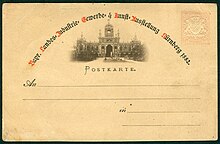
Back Fototípia Catalan Světlotisk Czech Lichtdruck (Druck) German Fototipia Spanish Valopaino Finnish Phototypie French Collotipia Italian コロタイプ Japanese Фототипия Kazakh 콜로타이프 Korean


Collotype is a gelatin-based photographic printing process invented by Alphonse Poitevin in 1855 to print images in a wide variety of tones without the need for halftone screens.[1][2] The majority of collotypes were produced between the 1870s and 1920s.[3] It was the first form of photolithography.[4]
- ^ "The Poitevin Patents and the Importance of Using Primary Sources". BrevetsPhotographiques.fr. Archived from the original on 2013-02-13.
- ^ Jones, Bernard Edward. Cassell's cyclopaedia of photography. Ayer Publishing.
- ^ "Photographic processes". Victoria and Albert Museum. Archived from the original on 2019-07-21. Retrieved 2021-01-20.
- ^ "Collotype". Society of American Archivists Dictionary. Society of American Archivists. Archived from the original on 2021-05-02. Retrieved 2021-11-12.